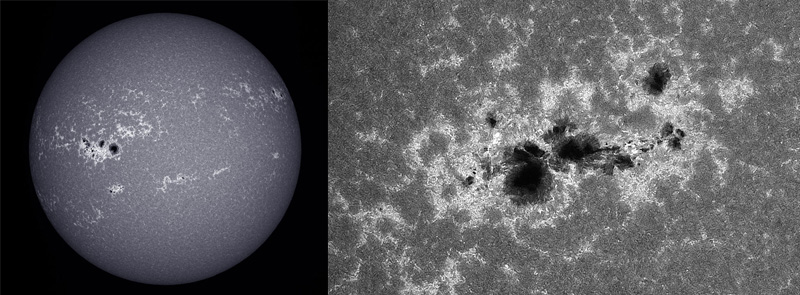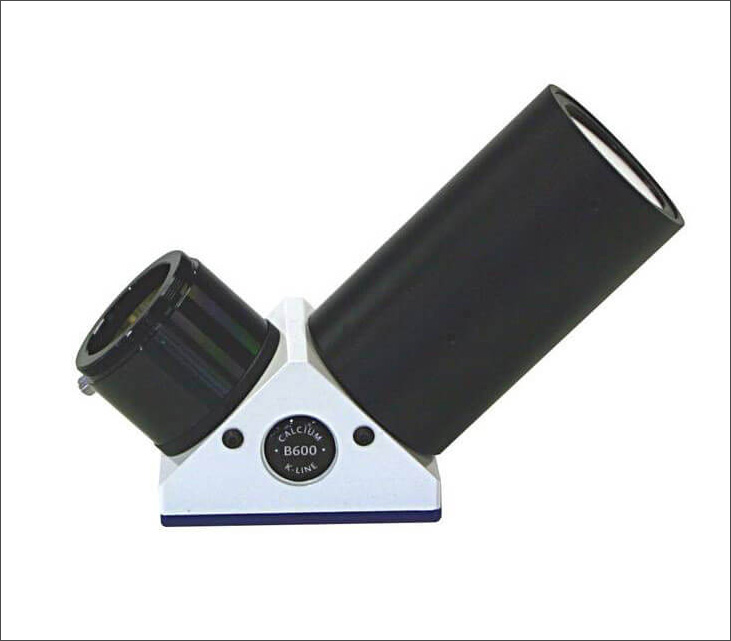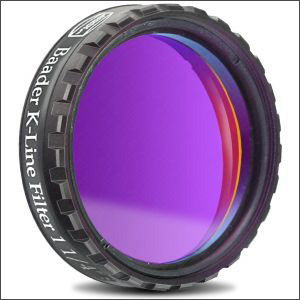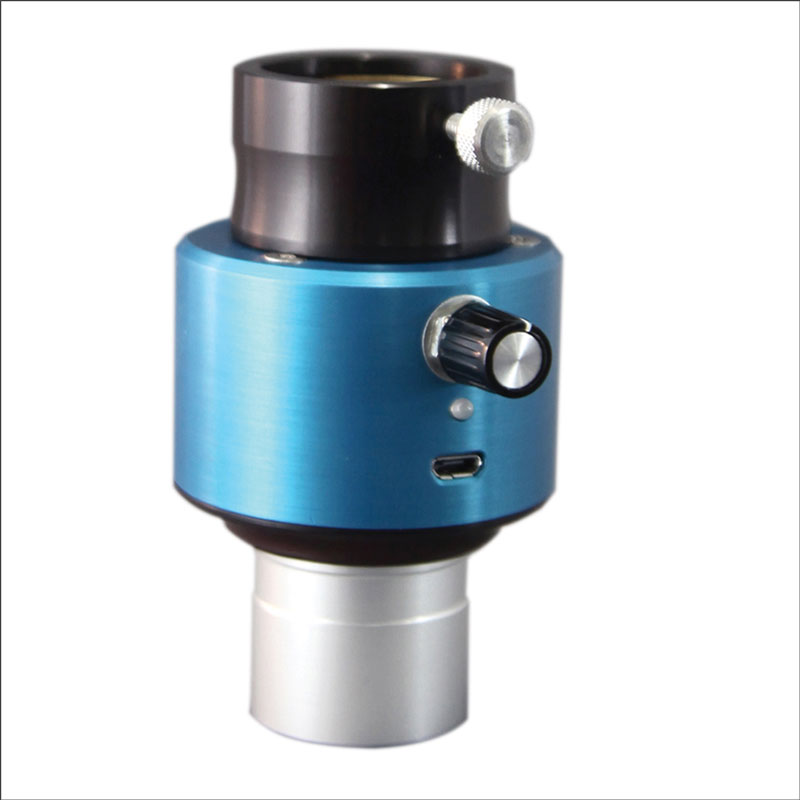Observing the Sun in Ca-K, Ca-H and Other Narrow Bandwidths
By: Brian Ventrudo and Manish PanjwaniDiscuss this article in the forums
November 16, 2016Overview
In past articles in this series on observing the Sun, you discovered what to observe in the Sun's photosphere, the region of the solar atmosphere that emits a broad band of brilliant white light. You also learned how to evaluate and select white-light solar filters to safely observe features in the photosphere such as sunspots, faculae, and granulation with a telescope or binoculars. In more recent articles, you discovered how observing the Sun with a narrow band solar filter that passes only red-orange light from hydrogen atoms at 656.3 nm can reveal features in the Sun's chromosphere such as solar prominences that are not visible in white light.
In this article, you will learn about another narrow band of light generated in the chromosphere, in this case the so-called Ca-K and Ca-H lines generated by calcium ions in the violet region of the spectrum. These lines show lower regions of the Sun's chromosphere and distinctive views of many solar features. Observing the Sun at these wavelengths, as well as at other lesser observed wavelengths such yellow light near 589 nm generated by sodium atoms, gives views and images of the Sun's chromosphere that complements H-alpha and white light observations.
 Figure 1 - The main solar absorption lines in the visible spectrum of the Sun: The Ca-H and Ca-K lines are to the left in the near ultraviolet. The sodium D lines are in the middle in the yellow region of the spectrum. The C line corresponds to H-alpha in the red part of the spectrum. In the chromosphere, these wavelengths are observed in emission, that is, the corresponding atoms and ions emit light at these wavelengths which is visible in a telescope equipped with a solar filter that passes light at these wavelengths. Credit: Wikipedia.
Figure 1 - The main solar absorption lines in the visible spectrum of the Sun: The Ca-H and Ca-K lines are to the left in the near ultraviolet. The sodium D lines are in the middle in the yellow region of the spectrum. The C line corresponds to H-alpha in the red part of the spectrum. In the chromosphere, these wavelengths are observed in emission, that is, the corresponding atoms and ions emit light at these wavelengths which is visible in a telescope equipped with a solar filter that passes light at these wavelengths. Credit: Wikipedia.7.1 Light from Calcium Ions: The Ca-K and Ca-H Lines
While most of the Sun is made of hydrogen and helium, there are traces of heavier elements inside the Sun and in its outer atmospheric layers. The complex spectrum of the Sun's atmosphere in which thousands of dark emission lines appear comes from these heavier elements which include calcium, sodium, iron, magnesium, and many others.
Calcium atoms that have lost a single electron, the so-called Ca-II ('calcium two') ions, emit and absorb light at several wavelengths, most notably at 396.9nm and 393.3nm in the violet region of the spectrum. These are the H and K lines of singly-ionized calcium, respectively. Compared to light from hydrogen alpha at 656.3 nm, these emission or absorption lines are broader in wavelength, which means solar filters that isolate and pass the light of these atomic transitions need not be as narrow as H-alpha filters. An effective H-alpha solar filter has a pass band of 1 angstrom or less (1 angstrom = 10-10 m). But solar filters that pass Ca-K or Ca-H have passbands of 2-10 angstroms.
Like the light from H-alpha, the light from Ca-H and Ca-K emission originates in the chromosphere. But it comes from the cooler and lower regions where the chromospheric features take on a slightly different appearance. At these wavelengths, the chromospheric network, the web of light-colored lines that weave through this part of the Sun's atmosphere, takes on a more prominent light-on-dark appearance. With narrower-band Ca-K and Ca-H filters, solar prominences are also visible along the limb, while dark filaments contrast nicely against the disk. Plages appear as bright cloud-like regions near sunspots, and the sunspots themselves are dark with an apparent structure in the violet spectrum quite similar to what is visible in white light. The brightness of light visible from Ca-K and Ca-H lines is strongly influenced by the local magnetic field near a solar feature. This gives rise to additional definition and contrast of regions and features in the lower chromosphere at these wavelengths.
Most amateur solar observers use Ca-K filters with their telescopes. Because the eye is not very sensitive at these violet wavelengths, which is especially true for older observers, the solar disk and its features are very hard to see visually at Ca-K and Ca-H wavelengths. Hence these filters are not usually used for visual observation of the Sun but are only used for imaging applications. Ca-H, which is 3.6 nm longer in wavelength and therefore slightly easier to see, is the preferred wavelength for visual observation, but this light is still hard to see visually. However, Ca-H filters require narrow bandwidths and more careful engineering because they must exclude the adjacent wavelength of hydrogen emission at 397.0 nm (the so-called H-epsilon transition). So Ca-K solar filters are far more common for amateur solar observation.
In this violet end of the spectrum, whether anything is visible at all depends quite strongly on the observer's eye. Generally, younger observers can see more detail at Ca-K and Ca-H wavelengths, but older observers who have had cataract surgery may also see some detail. Even if the overall solar disk is faintly visible to the eye of lucky observers at Ca-K and Ca-H wavelengths, it may be difficult to resolve any detail during visual observation.
Because of the challenge of visual observations in this wavelength range, solar observers most commonly use Ca-K filters and telescopes to image the Sun, either with suitable CCD or CMOS astronomy cameras or live webcam or video astronomy cameras constructed to operate in the violet region of the visible spectrum. The output from a video camera can be outputted to a video monitor for live solar viewing at Ca-K wavelengths.
 Figure 2a (left) - The full solar disk imaged with a Ca-K solar filter. Figure 2b (right) shows a close up of a sunspot group in Ca-K. These images were captured in monochrome with a Ca-K filter that passes ultraviolet light in a narrow band at 393.3 nm. Credit: Sergio Castillo
Figure 2a (left) - The full solar disk imaged with a Ca-K solar filter. Figure 2b (right) shows a close up of a sunspot group in Ca-K. These images were captured in monochrome with a Ca-K filter that passes ultraviolet light in a narrow band at 393.3 nm. Credit: Sergio Castillo7.2 Options for Ca-K and Ca-H Solar Filters
To observe and image the Sun at Ca-K or Ca-H wavelengths, it is essential to equip a telescope with an appropriate filter assembly that is intended for safe solar observation or imaging. There are a number of solutions for Ca-K including:
Lunt Solar Ca-K Diagonal: Lunt Solar makes a dedicated Ca-K diagonal for astronomical telescopes, generally refractors with ‹100mm objectives. These modules incorporate a Ca-K filter that passes light in a 2.4 angstrom band and a blocking filter to reduce the Sun's light to a safe level. The Ca-K diagonal simply slides into a 2-inch focuser of an astronomical telescope and it is ready to go. The module can be ordered with blocking filters of a variety of apertures to match the image size produced by telescopes from 600mm to 3400mm focal length.
Lunt also makes a Ca-K module package for their Lunt 152THa hydrogen alpha telescope. This package includes the Ca-K diagonal and a focuser. The user simply removes the H-alpha filter assembly and focuser on the telescope and inserts this Ca-K assembly to turn the Lunt 152THa into a Ca-K scope.
 Figure 3 - The Lunt CaK solar diagonal. Credit: Lunt Solar Systems.
Figure 3 - The Lunt CaK solar diagonal. Credit: Lunt Solar Systems.Baader Ca-K Solar Filter: Baader supplies a Ca-K 1.25" filter which threads into a standard astronomical eyepiece, if the observer wants to attempt visual observation, or into a camera nosepiece for imaging. The filter has a bandwidth of 80 angstroms (8nm) and MUST NOT be used as a stand-alone solar filter--it passes far too much light and can lead to immediate damage of your eye or imaging equipment. To reduce light to a safe level, the Baader Ca-K filter comes with a sheet of Baader AstroSolar film which is used to make a white-light solar filter than mounts over the objective of a telescope to reduce the Sun's light to a safe level before passing through the Ca-K filter. For better image quality, a Herschel wedge or similar solar wedge can be used in place of the AstroSolar film to reduce the solar intensity to a safe level for imaging and observation.
The Ca-K filter and AstroSolar film, which are sold as a package, are a more cost-effective solution than a specialized Ca-K module. However, the wide bandwidth of this filter (80 angstroms) produces a reduced contrast compared to many other Ca solutions, and this makes it difficult to see delicate features like solar prominences at the Sun's limb.
 Figure 4 - The Baader Calcium-K filter. The filter MUST be used with Baader AstroSolar film or a solar wedge to reduce the solar intensity to a safe level. Credit: Baader Planetarium
Figure 4 - The Baader Calcium-K filter. The filter MUST be used with Baader AstroSolar film or a solar wedge to reduce the solar intensity to a safe level. Credit: Baader PlanetariumResearch-Grade Ca-K Filter: DayStar Filters offers a research-grade Ca-K filter with a bandwidth of 2 angstroms for telescopes of long focal ratio (f/15 or greater). This filter provides excellent contrast for indoors visual observation or for imaging. This is a solution for serious and well-heeled solar observers as these units begin at about $4,000.
Most amateur solar observers image or visually observe the Sun at H-alpha or Ca-K wavelengths. But as mentioned above, the Ca-H line at 396.9nm is a slightly better choice for visual observation because the eye is more sensitive at this slightly longer wavelength (compared to Ca-K). High-end commercially available solutions for Ca-H observation include a research-grade Ca-H filter from DayStar Filters.
DayStar Filters also makes a line of solar 'eyepiece filters'--brand named the Quark- that operate at several wavelengths for solar observation, including Ca-H and H-alpha. The line of Quark filters are engineered to work with refractors, most commonly, though H-alpha versions can work with Schmidt-Cassegrain and Maksutov-Cassegrain telescopes at some solar wavelengths. Like an eyepiece, the Quark fits into the telescope diagonal and requires no additional filtering when used with refractors of less than 100 mm aperture. Just insert the DayStar Quark into your diagonal, power it up for a few minutes, insert an eyepiece, and observe.
Larger telescopes need an extra energy rejection filter (ERF) to keep the image brightness at a safe level and reduce heat buildup in the telescope tube when using the Quark. The Quark incorporates all the optical filter components necessary for safe narrow band solar observing. It also includes a built-in 4.2x Barlow lens, which increases the magnification and the image size. Unlike other narrow band solar filters, the Quark requires an external power source to control the temperature of the sensitive optics inside. The Quark Ca-H solar eyepiece works best with refractors of f/7 or slower and the bandwidth is around 5 angstroms.
 Figure 5 - The DayStar Quark Calcium-H solar eyepiece. Credit: DayStar Filters
Figure 5 - The DayStar Quark Calcium-H solar eyepiece. Credit: DayStar Filters7.3 Observing the Sun at Other Wavelengths
Neutral sodium (Na) atoms emit light at two wavelengths, 589.0nm and 589.6nm, that are known as the Na-D lines. Observations of light emitted by sodium at these wavelengths, which are in the yellow region of the spectrum, show a very high level of detail in granulation and in magnetic-field effects such as the footprints of solar flares in the lower chromosphere. DayStar Filters offers a research-grade dedicated Na-D solar filter assembly and a Quark solar eyepiece that passes sodium D.
 Figure 6 - Images of the Sun in H-alpha (left), sodium-D (middle), and calcium-K (right). Credit: DayStar Filters
Figure 6 - Images of the Sun in H-alpha (left), sodium-D (middle), and calcium-K (right). Credit: DayStar FiltersAdvanced solar observers and professional astronomers sometimes image the Sun with a filter that passes narrow band light at another wavelength, 587.6 nm, which corresponds to the so-called D3 line of helium in the yellow region of the spectrum. It is quite close to the Na-D lines, but it shows additional sunspot detail, supergranulation, plage, flare footprints, and absorption in magnetic regions.
 About the Author
About the Author
Brian Ventrudo is a writer, scientist, and astronomy educator. He received his first telescope at the age of 5 and completed his first university course in astronomy at the age of 12, eventually receiving a master's degree in the subject. He also holds a Ph.D. in engineering physics from McMaster University. During a twenty-year scientific career, he developed laser systems to detect molecules found in interstellar space and planetary atmospheres, and leveraged his expertise to create laser technology for optical communications networks. Since 2008, Brian has taught astronomy to tens of thousands of stargazers through his websites OneMinuteAstronomer.com and CosmicPursuits.com.
 About the Author
About the Author
Manish Panjwani has been an active amateur astronomer since before Halley's Comet last flew by our neighborhood. A former wireless communications consulting engineer and management consultant to various Fortune 500 companies, Manish started Agena AstroProducts in 2003. Since then, Agena has become one of the leading online retailers of telescopes and astronomical accessories worldwide. Besides observing from his heavily light polluted backyard in Los Angeles, Manish enjoys conducting astronomy outreach programs in local schools. Manish also holds a Master's degree in Electrical Engineering from Virginia Tech and an MBA from the Kellogg School of Management at Northwestern University.
***
This article is © AstronomyConnect 2016. All rights reserved.
Dismiss Notice
New Cookie Policy
On May 24, 2018, we published revised versions of our Terms and Rules and Cookie Policy. Your use of AstronomyConnect.com’s services is subject to these revised terms.

